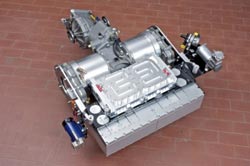Optimizing Electric Motors for Cars and Aircraft

The project Plug&Play Range Extender is examining how a module made of a small, fuel-efficient combustion engine and an alternator can increase the range of electric cars. In the project PELiKAn (a German acronym for the phrase “Power Electronics in Motor Vehicles and Aeronautics), the aim is to use highly efficient power electronics to improve efficiency in aircraft and motor vehicles. Both projects are receiving support from the German Federal Ministry of Education and Research (BMBF).
As the electrification of aircraft and motor vehicles gains ground, factors like the efficiency, required installation space, and weight of individual components are playing a crucial role. Power transformers are key components for which ever higher switching frequencies are required. At present, the energy required for the activation of a power switch is lost, which limits the maximum efficiency to 95 percent.
The partners in the PELiKAn project are therefore working to develop compact and reliable voltage transformers with an efficiency of up to 99 percent. The aim is to achieve this level of efficiency with “regenerative drive circuits,” which reduce the drive power needed by storing energy in a buffer. Researchers also expect that new types of semiconductor materials, such as silicon carbide, and higher maximum operating temperatures will further reduce the switching losses and forward losses experienced by switches.
Siemens is working on the three-year PELiKAn project with partners Daimler, EADS, Infineon, ZF Electronics, and the Fraunhofer Institute for Integrated Systems. The scientists of the global Siemens research department Corporate Technology are particularly focused on new switching concepts and on regulation and control technologies.
In the project Plug&Play Range Extender, the consortium of FEV, Siemens, Daimler, and the RWTH Aachen University will first define the requirements for a large-scale integrated Range Extender Module. In addition, marketable automotive designs will be drawn up. In a later phase, a vehicle with the Range Extender Module will then be built.
Media Contact
More Information:
http://www.siemens.com/innovationnewsAll latest news from the category: Automotive Engineering
Automotive Engineering highlights issues related to automobile manufacturing – including vehicle parts and accessories – and the environmental impact and safety of automotive products, production facilities and manufacturing processes.
innovations-report offers stimulating reports and articles on a variety of topics ranging from automobile fuel cells, hybrid technologies, energy saving vehicles and carbon particle filters to engine and brake technologies, driving safety and assistance systems.
Newest articles

Parallel Paths: Understanding Malaria Resistance in Chimpanzees and Humans
The closest relatives of humans adapt genetically to habitats and infections Survival of the Fittest: Genetic Adaptations Uncovered in Chimpanzees Görlitz, 10.01.2025. Chimpanzees have genetic adaptations that help them survive…

You are What You Eat—Stanford Study Links Fiber to Anti-Cancer Gene Modulation
The Fiber Gap: A Growing Concern in American Diets Fiber is well known to be an important part of a healthy diet, yet less than 10% of Americans eat the minimum recommended…

Trust Your Gut—RNA-Protein Discovery for Better Immunity
HIRI researchers uncover control mechanisms of polysaccharide utilization in Bacteroides thetaiotaomicron. Researchers at the Helmholtz Institute for RNA-based Infection Research (HIRI) and the Julius-Maximilians-Universität (JMU) in Würzburg have identified a…



